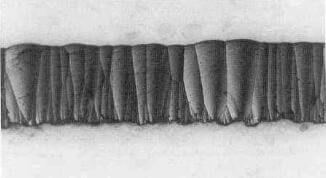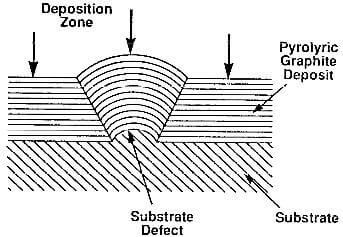Pyrolytic graphite is an aggregate of graphite crystallites which have dimensions that may reach several hundred nm. It has a turbostratic structure, usually with many warped basal planes, lattice defects, and crystallite imperfections.
Within the aggregate, the crystallites have various degrees of orientation. When they are essentially parallel to each other, the nature and the properties of the deposit closely match that of the ideal graphite crystal.
The structure of a pyrolytic graphite deposit can be either columnar, laminar, or isotropic, depending on the deposition conditions such as temperature, pressure, and composition of the input gases. It is possible to obtain the desired structure by the proper control of these deposition parameters.

fig.7.4-columnar structure of pyrolytic graphite.
Columnar structure: The columnar structure of pyrolytic graphite is shown in fig.7.4. The crystallites are deposited with the basal plane essentially parallel to the deposition surface. Their structure tends to be columnar as a result of uninterrupted grain growth toward the reactant source.
Effect of substrate geometry: The smoothness of the substrate is a very critical factor. Fig. 7.5 shows schematically the growth of the graphite deposit above a convex surface defect of the substrate such as a surface asperity or a dust particle. The deposit tends to magnify any such surface imperfection and, to obtain a uniform pyrolytic graphite growth, a perfectly smooth and clean surface is necessary.

fig.7.5-effect of substrate defect on deposited structure of pyrolytic graphite